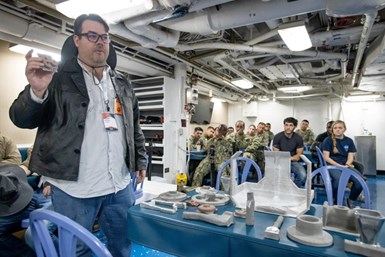Spee3D’s Metal 3D Printer First in World to Print Parts on US Naval Ship
Spee3D’s WarpSpee3D additive manufacturing technology was successfully used in the U.S. Navy’s REPTX exercise, which serves to demonstrate and evaluate the viability and efficacy of products and services that could expand the Navy’s ability to perform expeditionary maintenance operations.
Spee3D Co-Founder and CTO Steve Camilleri shows the company’s metal 3D printed parts to the U.S. Navy. Photo Credit: U.S. Navy photo by Eric Parsons
Speed3D’s WarpSpee3D metal printer has been used to successfully print the first ever 3D printed parts on a U.S. Navy ship. The company’s additive manufacturing (AM) technology was chosen as part of NAVSEA’s REPTX exercise, which was conducted as part of ANTX-Coastal Trident 2022 at the Naval Base Ventura County in Port Hueneme, California.
The WarpSpee3D printer test successfully printed a bronze anchor five times while the vessel was engaged at sea. Parts were printed with the same results and all within just six minutes each time. In addition, the Spee3D team assisted other companies with their trials, helping print a range of applications, including pressure fittings for pipes, protective boxes for naval equipment and manufacturing mechanisms for robotic arms.
“Our goal during REPTX was to successfully test WarpSpee3D’s deployable technology to print maritime military parts on demand and in various sea conditions. We’re thrilled the results are favorable and that Spee3D is the world’s first to print parts on a ship,” says Steven Camilleri, Spee3D co-founder and CTO. “We understand the operational, economic and supply chain issues the military faces and look forward to continuing to work with U.S. Defense to help solve some of these challenges.”
2022 REPTX is a research event for government, academia and industry participants to demonstrate and evaluate the viability and efficacy of products and services that could expand the Navy’s ability to perform expeditionary maintenance operations. The event was conducted as part of ANTX-Coastal Trident 2022, which had more than 60 naval, academia and industry participants. The trial consisted of a series of technical demonstrations, field experiments and exercises, both discussion- and operations-based.
REPTX aims to identify, validate and implement new technologies — including AM — to help reduce supply chain issues, perform maintenance operations more efficiently and limit travel time back to port.
Spee3D says its technology is 1,000 times faster than other metal 3D printers. The technology is said to harness the power of kinetic energy, rather than relying on high-power lasers and expensive gasses, thereby enabling printing at affordable production costs. The company says parts can be printed anywhere in minutes from more than 12 material sets, including copper, stainless steel, titanium, high-strength aluminum and nickel-based carbides. WarpSpee3D is the world’s first large-format metal 3D printer to use Spee3D’s technology.
Related Content
-
This Year I Have Seen a Lot of AM for the Military — What Is Going On?
Audience members have similar questions. What is the Department of Defense’s interest in making hardware via 3D printing over conventional methods? Here are three manufacturing concerns that are particular to the military.
-
For Coast Guard, AM Adoption Begins With “MacGyver-ish” Crew Members Who Are Using 3D Printing Already
AM suits the Coast Guard’s culture of shipboard problem-solving, says Surface Fleet AM lead. Here is how 3D printers on ships promise to deliver not just substantial cost savings but also an aid to crew capabilities and morale.
-
The Top 10 Additive Manufacturing Stories of 2024
Defense, space exploration, thermal management — these are some of the topics that captured the Additive Manufacturing audience’s interest in 2024. But there’s also an overarching theme: Don't wait for additive manufacturing to be perfect. Instead, leverage the applications perfect for AM.















